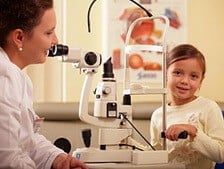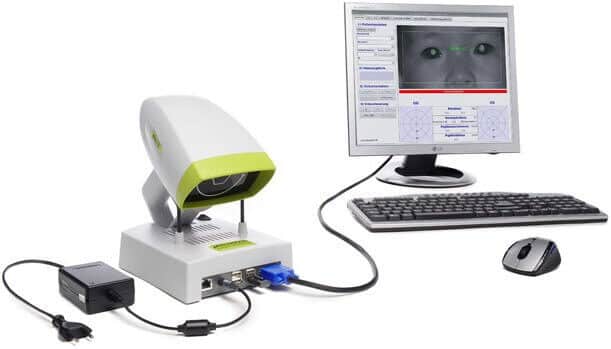Why do children need vision diagnostics?
As a rule, the child’s visual system is formed up to the age of 18. It develops most actively up to the age of six or seven and continues through the school years. Children’s vision is affected by many negative factors: early and excessive visual stress, non-observance of the visual regime, unfavorable ecological conditions, hereditary factors. Children, especially young children, rarely complain about their eyesight themselves, and even the most attentive parents often may fail to notice visual impairment in their children.
Potential threats and hidden processes can be detected even at their onset and a complete picture of the child’s visual system can be obtained only through a comprehensive examination of the visual system. Routine and proper diagnostics of visual impairment in children enables timely prevention or treatment and thus avoids many serious vision problems such as progressive myopia, strabismus, or amblyopia. After all, a child’s flexible visual system responds well not only to negative influences but also to therapeutic effects.
The proper time to see a pediatric ophthalmologist
The first examination of the child by an ophthalmologist takes place in the maternity home and is aimed at detecting congenital diseases (cataract, retinal tumor, glaucoma, inflammatory diseases). Premature babies must be examined to rule out retinal pathologies such as retinopathy of prematurity and optic nerve atrophy.
There are certain periods when, even if there are no pathologies, it is still required to check the eyesight: at the age of one month, six months, three years, six or seven years, in the third to fifth, ninth, and eleventh grades. If the child already has a visual impairment, examinations should take place once a year; if there are serious pathologies, then once every six months.
Attention!
Parents should contact an ophthalmologist without waiting for a routine check-up if they notice that the child’s eyes are blurred, obscured; if the child does not look at an adult’s face at two or three months, does not recognize his/her mother; if one or both eyes deviate from the correct position; if one eye does not open fully or if the child turns his/her whole head to look at you. At school age, the following may be alarming symptoms: the child rubs his/her eyes, squints, leans low when reading and writing, complains of headaches, and tires quickly.
What is the difference between a comprehensive pediatric vision test and a routine eye exam?
Many clinics, kindergartens, and schools are still applying outdated technology to measure visual acuity with a chart that hangs on the wall. Such a test measures a single parameter of the visual system – visual acuity, and even a 100% acuity does not always mean that everything is fine and their vision is not threatened. A quick examination by a school ophthalmologist in contrast to comprehensive diagnostics cannot reveal the ongoing processes in the developing child’s visual system. The Eximer Ophthalmology Clinic performs a full diagnostic examination of the child’s entire visual system with computerized equipment. Accurate diagnostics of a child with visual impairments allows you to find out the cause and extent of the disease and prescribe an effective treatment.
Cases when a child needs an eye exam
- Myopia
- Strabismus
- Amblyopia
- Astigmatism
- Hyperopia
Benefits of checking your child’s vision at Eximer Ophthalmology Clinic
- You get a full picture of your child’s vision system, consultation from a pediatric ophthalmologist, and, if necessary, a preventive or treatment program in one visit.
- Eximer Ophthalmology Clinic features a specialized pediatric department with all modern facilities for comprehensive diagnostics of children’s vision.
- The clinics are equipped with a set of computerized diagnostic devices, allowing a comprehensive assessment of the young patients’ vision and, if treatment is needed, it can be individually selected with the most effective methods.
- The cost of a comprehensive eye exam in Eximer Ophthalmology Clinic includes the necessary tests and a consultation with an ophthalmologist.
- Pediatric ophthalmologists have extensive experience even with the youngest patients.
- The findings during the examination and computer diagnostics of children’s vision are recorded in a database and allow the doctor to follow the dynamics, which is very important for the child’s developing visual system, as well as to adjust the treatment course.
- The pediatric departments of Eximer Ophthalmology Clinic are arranged and designed in such a way that both children and parents feel comfortable here.
Peculiarities of child vision diagnostics at Eximer Ophthalmology Clinic
- An appointment at Eximer Ophthalmology Clinic begins with a pediatric ophthalmologist. The doctor asks the child and their parents about their complaints, lifestyle, and eye strain. Eximer Ophthalmology Clinics are staffed by experienced pediatric ophthalmologists who know how to communicate with young patients.
- Children cannot explain properly the way they see. Eximer Ophthalmology Clinic employs brand-new pediatric diagnostic equipment to make all the necessary readings contact-free, quickly, and with the highest accuracy. This is crucial when checking the eyesight of very young children. Thus, the unique PlusOptix A09 pediatric autorefractometer allows measuring refraction (refracting power of the eye optical system) of any age group including infants. All measurements with this equipment are performed in a playful manner.
- Diagnostic examination of the child’s visual system involves a pupil dilation procedure. It is safe but requires some time. Pupil dilation is needed to obtain objective data about the child’s visual system, to rule out congenital abnormalities, and, if the vision deteriorates, to determine the true cause for the correct treatment.
- Based on the diagnostic examination, a pediatric ophthalmologist provides recommendations for the distribution of eye strain, and if necessary, prescribes a set of preventive or curative (hardware, physical therapy) procedures, selects glasses or contact lenses.
Examinations included in the child vision diagnostics program at Eximer Ophthalmology Clinic:
- Visual acuity measurement;
- Refraction measurement;
- Eye ground exam with pupil dilatation;
- Measurement of eyeball length, corneal curvature, anterior chamber depth, and lens size;
- Testing binocular function (the brain’s ability to create one 3D image from what each eye sees separately);
- Checking the visual fields;
- Testing the reserve of accommodation.
The following tests are prescribed as indicated:
- Determination of retinal condition in turbid media (congenital cataract);
- Non-contact intraocular pressure measurement;
- Detailed examination of the eye structures;
- Visual examination of the ocular anterior chamber;
- Examination of the eye ground to assess the condition of the retina, optic disc, and vessels of the eye ground;
- Examination of the cornea on the anterior eyeball analyzer.
Why can’t glasses be fitted immediately after an eye exam?
Modern, full diagnostic exams involve a dilated pupil to study the internal structures of the eye and the eye ground. It is not that easy to pick the right glasses with a dilated pupil, so you will need a separate visit at Eximer Ophthalmology Clinic to get your glasses or contact lenses fitted.











